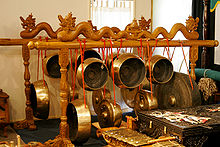Kecak (pronounced [ˈketʃaʔ], alternate spellings: Ketjak and Ketjack) is a form of Balinese dance andmusic drama, originated in the 1930s Bali and is performed primarily by men, although a few women's kecak groups exist as of 2006.[1]
Also known as the Ramayana Monkey Chant, the piece, performed by a circle of 150 or more performers wearing checked cloth around their waists, percussively chanting "cak" and throwing up their arms, depicts a battle from the Ramayana where the monkey-like Vanara helped Prince Ramafight the evil King Ravana. However, Kecak has roots in sanghyang, a trance-inducing exorcismdance.[2]
History
Kecak was originally a trance ritual accompanied by male chorus. German painter and musicianWalter Spies became deeply interested in the ritual while living in Bali in the 1930s and worked to recreate it into a drama, based on the Hindu Ramayana and including dance, intended to be presented to Western tourist audiences. This transformation is an example of what James Clifford describes as part of the "modern art-culture system"[3] in which, "the West or the central power adopts, transforms, and consumes non-Western or peripheral cultural elements, while making 'art' which was once embedded in the culture as a whole, into a separate entity."[4] Spies worked with Wayan Limbak and Limbak popularized the dance by traveling throughout the world with Balinese performance groups. These travels have helped to make the Kecak famous throughout the world.
| Music of Indonesia | |
|---|---|
 Gongs from Java | |
| Timeline • Samples | |
| Genres | |
| Specific forms | |
| Regional music | |
Performer, choreographer, and scholar I Wayan Dibiacites a contrasting theory that the Balinese were already developing the form when Spies arrived on the island.[5] For example, well-known dancer I Limbakhad incorporated Baris movements into the cak leader role during the 1920s. "Spies liked this innovation," and it suggested that Limbak, "devise a spectacle based on the Ramayana," accompanied by cak chorus rather than gamelan, as would have been usual.[2]
- The 1971 version of Kenneth Anger's Rabbit's Moon incorporates Kecak into the soundtrack.
- Footage of a kecak performance is prominently featured in Ron Fricke's 1992 film Baraka.
- A kecak chant can be heard in Federico Fellini's classic 1969 film Satyricon. It was probably sampled from David Lewiston's 1969 LP of Balinese music entitled Golden Rain, released on the Nonesuch Explorer Series.
- Dagger of Kamui (Kamui no Ken), an anime film released in 1985, incorporates kecak in its score, often in action scenes involving shinobi.
- Kecak chanting is incorporated into the soundtrack for the Japanese animated film Akira(1988), which also uses the Indonesian gamelan prominently.
- Kecak is heard in I Never Promised You a Rose Garden during fantasy sequences taking place in the heroine's paracosm.
- A Kecak-style dance and chant can be seen in the fantasy portion of Tarsem Singh's filmThe Fall (2006), in which the Balinese actors incorporated words to describe the map being drawn.
- John Adams' "A Flowering Tree," 2006. Kumudha and the beggar minstrels in Act II is based on the Kecak. (Cincinnati Opera pre-performance interview with the composer, 30 June 2011.)
- A sample of Kecak chanting kicks off The Pop Group's 1980 album For How Much Longer Do We Tolerate Mass Murder?
- There is a sample of Kecak chanting on "The Wind Chimes" from Mike Oldfield's 1987 album Islands.
- The San Francisco Art Rock band Oxbow's song Daughter from their 1991 album King of the Jews incorporates Kecak-inspired polyrhythmic chanting and clapping throughout.
- Mike Patton performs a Kecak-like chant that is incorporated in the song "Goodbye Sober Day" on the 1999 Mr. Bungle album California. Patton had previously performed a similar passage of rhythmic chanting in the Faith No More song "Got That Feeling," from their 1997 Album of the Year.
- A song from the debut album by musical group Hercules and Love Affair has an intro in the style of Kecak chanting.
- A sample of Kecak chanting can be heard in the song "Soldier of Fortune" from Manhattan Transfer's album Bodies and Souls.
- A sample of Kecak chanting can be heard in the Devo song Jocko Homo.
- A sample of Kecak chanting can be heard near the end of the Nurse With Wound track "I Am Blind" from the album Homotopy to Marie.
- David Attenborough's 1969 documentary for the BBC The Miracle of Bali on the arts in Bali featured the kecak in both the 1st and 3rd episodes.
- A Kecak dance is performed in a Season 2 episode of MTV's Wildboyz, with Chris Pontius and Steve-O participating in the ritual during their stay in Indonesia.
- Kecak chanting forms the basis of the song "The Oracle" in the Super NES video game Secret of Mana.
- Kecak chanting is featured in the song "Kecak" in the Japanese music video game beatmania IIDX 11 – IIDX RED. Samples for this song are taken from Fellini's "Satyricon."
- Kecak is a mini-game in Capcom's Breath of Fire IV video game for PlayStation. The player mimics the chants by timing button presses corresponding to the screen.
- Kecak chanting is used as theme music for one of the unlock able enemy generals in the Atari game "Risk".
- Ketjak is a book-length poem by Ron Silliman published in 1978 and reprinted in The Age of Huts (2007), in which the author gives the title "Ketjak" to a vast ongoing cycle of works which includes Tjanting (1980) and The Alphabet (2008).
- RMB, a famous music formation in the nineties, also sampled tunes from Kecak in their track called "Chakka chakka".



Tidak ada komentar:
Posting Komentar